
We’ve written about the Ruger Mini Thirty in great detail on numerous occasions, along with other Mini related subjects including the Mini-Cooper, Minnie Driver and Minnie Mouse. All of which, we feel, uniquely qualifies us as having Mini expertise when it comes to this Ruger firearm. It is with this foundation, so steeped in knowledge, that we have elected to move on to produce “Ruger’s Mini Thirty-ish”, the prequel, which is an adaptation of the Austrian play “Meine Lederhosen sind mir Scheuern”, written by Van de Graaff .
Within this prequel, we took the novel approach of beginning with an untarnished and unadorned Mini Thirty, then baselined its performance BEFORE modifications were made and BEFORE we claimed dramatic improvement… based on our mini gun tinkering prowess. The second phase, or as we like to say “Phase II” will follow with the execution of a combination of both popular and unpopular performance modifications with all wins, losses and draws duly, if not dually recorded.
At the conclusion of both phases, Real Guns will host an IHOP breakfast extravaganza at the I-90 Rapid City, South Dakota exit. At that time, staff members will solicit reader response to the article and Mark Gurney will arm wrestle R.J. Molinere, briefly, to determine the winner of the “I’ve Been to Wall Drugs” T-Shirt contest. Can’t wait. Really…
A brief introduction…
|
Ruger Mini Thirty |
|
|
Manufacturer |
Ruger |
| Model | 5854 |
| Hardware Finish | Blued Carbon Steel |
| Stock | Black Synthetic |
| Action Type | Fixed Piston Gas – Semi Auto |
| Caliber | 7.62 x 39mm |
| Magazine Capacity | 20 Rounds – As Received |
| Barrel Length | 16.12″ |
| Twist Rate | 1:10″ |
| Adjustable Sights | Ghost Aft – Blade Front |
| Scope Mounting | Integral Mounts – Rings Included |
| Overall Length | 37.5″ |
| Length of Pull | 13″ |
| Weight | 6 lbs 12 oz Empty |
| Trigger Pull | 6 lbs 9 oz |
| MSRP | $989 |
| Discount Retail | $784 |
In paraphrase, the Ruger describes the Mini Thirty as a gas operated, box magazine fed, autoloading rifle. It utilizes a proprietary fixed piston/moving cylinder gas system in conjunction with a simplified Garand-type rotating bolt. The rifle is chambered for an excellent deer hunting cartridge, the 7.62 x 39mm.
The safety, located in front of the trigger guard, blocks both the hammer and sear and permits the slide to be cycled with the safety “ON.” A bolt lock mechanism is provided for convenience in holding the bolt open for loading and inspection. The firing pin is retracted mechanically as the bolt starts to unlock and the rifle will fire only when the bolt is locked. For a thorough and detailed break down of the firearm, its subassemblies and operation, please see our initial coverage.
The general look of the Mini Thirty is that of a reduced size M-14, however, the feel of the rifle is closer to a compact and fast handling M1 Carbine. In fact, an M1 carbine was parked at the shooting bench and shot along side the Mini Thirty for context. Operation and actuation is about the same… the Mini Thirty’s magazine loads differently. The M1 is a straight upward, the Mini Thirty magazine enters the magazine well and then rolls back into position. Too aficionados of either, I am sure the differences are monumental. For a person who wants to just shoot, rather than embrace one… they are pretty much the same in the handling and heft department.
7.62x39mm ammunition… or “amanition” as my buddy Lewis use to say
I don’t know how many times I’ve read where someone was haranguing Ruger for not being forthright regarding the use of cheap eastern European or Russian produced steel case 7.62x39mm ammunition in the Mini Thirty. They might try reading the manual, which is of course included with each firearm and posted on the Ruger website in downloadable form. It reads –
“The Mini-14 Ranch and Mini Thirty Rifles are designed to use either standardized U.S. military, or factory loaded sporting cartridges manufactured in accordance with U.S. industry practice. Always be careful to ensure you are using the correct ammunition for your rifle. See “Ammunition Notice” & “Warning – Ammunition,” USE ONLY FACTORY AMMUNITION LOADED TO U.S. INDUSTRY STANDARDS”. Seems straight forward, check the labels on ammunition to see if it meets these requirements. But wait, Nate, there is more… much, much more… as none of the 6,002 boxes of ammo stacked in waiting, or weighting on my desk indicate anything more than country of origin!.. !!
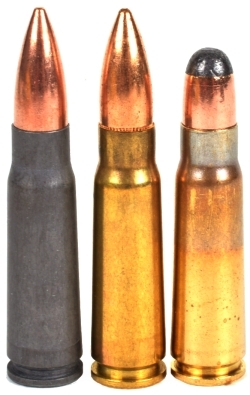 Maybe it’s just me, but that passage would probably send me out looking for ammunition produced in the United States by SAAMI member companies and not labeled for export or foreign military compliance. Center, Federal American Eagle; U.S. made, brass case, Boxer primed.
Maybe it’s just me, but that passage would probably send me out looking for ammunition produced in the United States by SAAMI member companies and not labeled for export or foreign military compliance. Center, Federal American Eagle; U.S. made, brass case, Boxer primed.
My video game playing rapscallion alter ego “Cap’n Slappy Jack Frobisher” might venture out to buy boxer primed CIP standard ammunition and check the live fire results for suitability. Right, Prvi Partizan, CIP spec, brass cased, boxer primed.
No one rolling around inside of my head would stretch to shoot steel cased, Berdan primed low quality Russian commercial or relic military. никогда!. Left, Herter’s Russian made International Select Grade; steel cased, Berdan primed, does not meet U.S. or CIP standards.
I learned a lesson back in the 1970s when I was trying to become a photo journalist… did not nail it, and needed a fast telephoto lens for my spiffy 35mm Nikon. A fast Nikkor telephoto lens at Willoughby-Peerless in New York was selling for $2,500 at the time. I had $37 and some pocket lint, so it seemed that if I wanted a lens, some compromise was in order.
I purchased what was sold as a 1000mm Russian mirror lens for $35 and had a celebratory lunch at the Tick Tock Dinner. Unfortunately, when I opened the lens box, I found a black cardboard tube with a Nikon mount adaptor glued to one end and a fixed f/1000 pin hole aperture at the other. It was great for photographing the sun without filters or a welding arc in an industrial setting. Sounds bad? It was, and so is Russian made, steel cased, Berdan primed 7.62x39mm ammunition. I did not blame my Nikon for not working with a junk accessory. Neither would I blame Ruger’s Mini Thirty for not working with grossly substandard ammo.
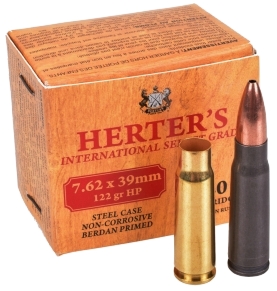 While I am not excited by Cabelas Herter’s International Select ammunition, this is in no way a condemnation of the Herter’s line of ammunition as there are two different types. The first is Herter’s Select Brand, which is Boxer primed, brass cased ammo, made in the Czech Republic by Sellier & Bellot to a CIP sporting ammunition standard. The second type, Herter’s International Select steel case, Berdan primed ammo, which is made along side of Tula and Wolf ammunition in Russia and the subject of our ire.
While I am not excited by Cabelas Herter’s International Select ammunition, this is in no way a condemnation of the Herter’s line of ammunition as there are two different types. The first is Herter’s Select Brand, which is Boxer primed, brass cased ammo, made in the Czech Republic by Sellier & Bellot to a CIP sporting ammunition standard. The second type, Herter’s International Select steel case, Berdan primed ammo, which is made along side of Tula and Wolf ammunition in Russia and the subject of our ire.
If this Russian ammo is so bad, one might ask, why does a classy retailer like Cabala’s sell the stuff? Because it is made for a different application; SKS and AK type firearms and similar that are designed to ingest this type of military spec ammunition, not the Ruger Mini Thirty. So why not change the Mini Thirty to use this cheap ammo? Because increasing hammer spring rates or increased firing pin protrusion to reliably ignite the harder and deeper anvil set Berdan primer would tend to cause some frequency of pierced Boxer primers when used. Considering the U.S. is clearly a Boxer primer market, and considering most people use good hunting and practice ammo, Ruger made the right choice.
For the sake of our baseline, and to define how bad is bad and how good is good when it comes to ammunition for the Mini Thirty, we settled on three representative brands/types of ammo, saving handloads for the improvement phase of the project. Top to bottom in the order pictured above…
|
Ammunition |
Bullet Type |
Bullet Weight Grains |
Rated FPS |
Recorded FPS |
Case Material |
Primer Type |
Origin | Price Box/20 |
| Herter’s International Select Grade | HP | 122 | 2396 | 3518 | Steel | Berdan | Russia | 5.99 |
| Federal American Eagle | FMJ | 124 | 2350 | 2351 | Brass | Boxer | U.S.A. | 19.99 |
| Prvi Partizan | SPRN | 123 | 2460 | 2452 | Brass | Boxer | Serbia | 9.99 |
All of the ammunition used in assessment, and probably all of the handload ammo produced going forward will utilize 0.310″to 0.311″ bullets in deference to the Mini-Thirty’s 0.3105″ groove diameter. The Mini-Thirty is not a 0.308″ rifle and never has been produced as such. Reports of sightings of early production 0.308″ guns permeates message boards and other places where rumors are born… Much like Unicorns, White Buffalos and unused WWII Jeeps found in crates in a warehouse in Buford, Wyoming. If you have one, produce it.
Ready to go, we rushed ahead and… built a brass catcher
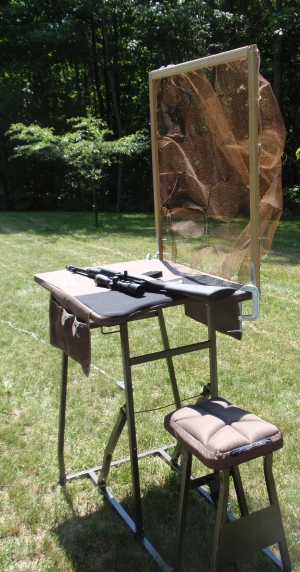
Whenever we run a firearm project that includes live fire, the series is always shot from a bench. These days, because there is so much data collecting gear to bring along, we’ve been trying different fold up benches to see if one will work for us. A weighted sled sits on top of the bench when firearm accuracy is being qualified, so a bench has to hold 60 or 70 pounds.
Sunday morning, with a Mini Thirty project in queue, my wife and I spent a couple of hours building a brass catcher for this portable shooting bench. Yes, we could have purchased one, but then we wouldn’t have had the enjoyment of figuring out how to make some pressure treated trim strips and an old piece of minnow seine into something more useful. So far, it works good, catching both rifle and handgun brass and, I suspect, minnows if the need arose.
Construction detail in brief… 32″x34″ to cover the length of the bench made of 1″x2″ pressure treated lumber, with glued lap joints. L brackets secured to the bottom face with screws allow clamping to the bench when in use. The net is a section of 1/4″ mesh minnow seine, stapled on the back, loosely so there is no surface tension, further secured with trim strip on the backside to make it more durable.
Testing, the catcher covers an appropriate area for use with virtually every rifle and pistol. A commercial catcher sells for about $50 – $60. This one cost nothing and it reduced the scrap pile in the basement.
Segue, segue, transition dream sequence…
The rifle was cleaned. A Leupold VX-3 2.5-8x36MM was installed on the Ruger Mini Thirty using the Ruger ring set included with the rifle. The scope had adequate magnification for the 100 yard ranges planned for this part of the project. A long tape was used to verify target placement 100 yards from the rifle’s muzzle at the bench. I apologize for the variety of targets, but I used the opportunity to also try out some target types.

The Russian Herter’s rounds seemed to be very independent minded with each of the three bullets deciding to reside a considerable distance from the others. However, it consistently grouped at 2 3/4″ even if the arrangement of hits varied significantly. It was also unreliable.

Over the course of chronograph data collection and group shooting, the ammo failed to fire 2 of 15 attempts with failures firing with a second attempt, none of which were used in accuracy checking. Steel isn’t the problem, it is the Berdan primer they incorporate. The poly coated steel had no bearing in the rifle feeding or cycling or powder charges not igniting. Berdan primers are harder than Boxer primers and the anvil, which is integral to the cartridge case, is deeper set than a Boxer primer with integral and more shallow anvil.
The Federal American Eagle functioned flawlessly, feed, cycling or ignition. Unfortunately, at 2 1/2″, it wasn’t much more accurate than the Russian ammo. Why the 4 shot, 3 shot group. I couldn’t believe the lowest shot was the rifle and not the 90ºF heat and 68% relative humidity and sweat running into my eyes, so I shot again before pulling the target and that shot sat right on top of the other. Interesting…

So I was settled in to a 2″ plus a bit routine when I shot this 5/8″ groups with the Prvi Partizan soft point ammo!!… !!!. This was backed up with a 3/4″ group,,, which left me so… puzzled. I’ve actually had good luck with Prvi ammo with other cartridges and rifles, so that wasn’t a great surprise. It was more the issue of the variation in group sizes based on ammo selection.
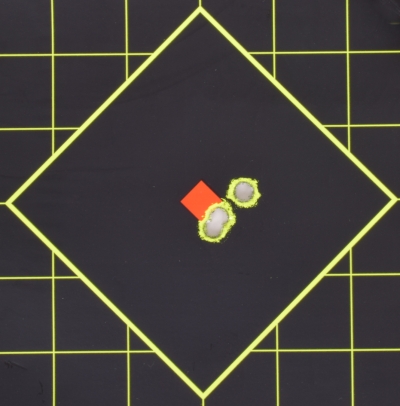
Bullet patterns within ammo selections varied significantly, however, they each remained close to an average overall group size for the ammo selection. Neat… I think.
What now? Head scratch, head scratch…
Comparatively speaking, the Ruger Mini Thirty shot about the same size large groups as a modern .30 caliber M1 carbine I also has at the bench, but the M1 never produced a 5/8″ group during any live fire testing. Additionally, the M1 carbine stove piped 1 of 5 shots and there was no ammo choice that solved that problem. So I think, with the Mini Thirty, I am in a much better place.
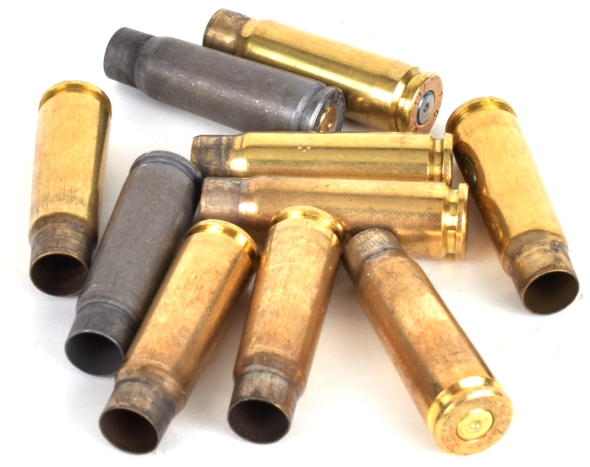
Since the change from 5/8″ to 2 1/2″ to 2 3/4″ group size can be affected with choice of ammo, it seems handloads could be developed to at different bullet weight and approximate this impressive level of performance. We’ve had good luck in the past, although not to this degree. That said, it might be more important to get the rifle to shoot most factory ammo near or at MOA.
In either case, I have no developed ideas as yet. We are going to take a break, determine an objective and assemble a plan that has a good chance of getting us there. If this statement makes no sense, please see “Good as Gold”, Joseph Heller for a more in-depth explanation.
Ruger’s Mighty Mini Thirty… ish Part I
Ruger’s Mighty Mini Thirty… ish Part 1½
Ruger’s Mighty Mini Thirty… ish Part 2
Ruger’s Mighty Mini Thirty… ish Part 3
Ruger’s Mighty Mini Thirty… ish Part 4

Email Notification